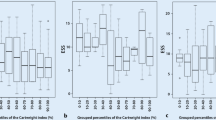Abstract
Purpose
The purpose of this study is to evaluate the impact of body position during sleep on apnea-hypopnea index (AHI) and night-to-night variability in polysomnography (PSG) parameters.
Methods
Totally, 30 patients with obstructive sleep apnea syndrome (OSAS) were assessed prospectively with successive PSGs performed. The patients were categorized as increased (group A), decreased (group B), and unchanged (group C) AHI between the first and second PSG evaluations performed at least 1-week interval.
Results
The mean AHI values were significantly higher in the second night (p = 0.02). A change in AHI was found in almost 85 % of the patients between two successive measurements. According to multivariate and correlation analyses and differences in total AHI in supine position (r = 0.897), it was found that the influence of the supine position was the primary factor contributing to the night-to-night variability. Supine AHI, non-supine AHI, and non-supine time findings did not add any significance on total AHI.
Conclusions
The variability observed in the AHI seems related to amount of sleeping time spent in supine position, suggesting that mean AHI alone is not that reliable in the accurate diagnosis of OSAS severity. A thorough evaluation of AHI in supine and non-supine positions is needed in order to understand better the severity of OSAS.



Similar content being viewed by others
References
Richard W, Kox D, den Herder C, Laman M, van Tinteren H, de Vries N (2006) The role of sleep position in obstructive sleep apnea syndrome. Eur Arch Otorhinolaryngol 263(10):946–950
Oksenberg A, Silverberg DS, Arons E, Radwan H (1997) Positional vs nonpositional obstructive sleep apnea patients: anthropomorphic, nocturnal polysomnographic, and multiple sleep latency test data. Chest 112(3):629–639
Le Bon O, Staner L, Hoffmann G, et al. (2001) The first-night effect may last more than one night. J Psychiatr Res 35:165–172
Gouveris H, Selivanova O, Bausmer U, Goepel B, Mann W (2010) First-night-effect on polysomnographic respiratory sleep parameters in patients with sleep-disordered breathing and upper airway pathology. Eur Arch Otorhinolaryngol 267(9):1449–1453
Stepnowsky CJ Jr, Orr WC, Davidson TM (2004) Nightly variability of sleep-disordered breathing measured over 3 nights. Otolaryngol Head Neck Surg 131(6):837–843
White LH, Lyons OD, Yadollahi A, Ryan CM, Bradley TD (2015) Night-to-night variability in obstructive sleep apnea severity: relationship to overnight rostral fluid shift. J Clin Sleep Med 11(2):149–156
Ahmadi N, Shapiro GK, Chung SA, Shapiro CM (2009) Clinical diagnosis of sleep apnea based on single night of polysomnography vs. two nights of polysomnography. Sleep Breath 13(3):221–226
Maestri R, La Rovere MT, Robbi E, Pinna GD (2011) Night-to-night repeatability of measurements of nocturnal breathing disorders in clinically stable chronic heart failure patients. Sleep Breath 15(4):673–678
Riedel BW, Winfield CF, Lichstein KL (2001) First night effect and reverse first night effect in older adults with primary insomnia: does anxiety play a role? Sleep Med 2(2):125–133
Bittencourt LR, Suchecki D, Tufik S, Peres C, Togeiro SM, Bagnato MC, Nery LE (2001) The variability of the apnoea-hypopnoea index. J Sleep Res 10(3):245–251
Randerath WJ, Verbraecken J, Andreas S, Bettega G, Boudewyns A, Hamans E, Jalbert F, Paoli JR, Sanner B, Smith I, Stuck BA, Lacassagne L, Marklund M, Maurer JT, Pepin JL, Valipour A, Verse T, Fietze I (2011) European Respiratory Society task force on non-CPAP therapies in sleep apnoea. Non-CPAP therapies in obstructive sleep apnoea. Eur Respir J 37(5):1000–1028
Bignold JJ, Mercer JD, Antic NA, McEvoy RD, Catcheside PG (2011) Accurate position monitoring and improved supine-dependent obstructive sleep apnea with a new position recording and supine avoidance device. J Clin Sleep Med 7(4):376–383
Ravesloot MJ, van Maanen JP, Dun L, de Vries N (2013) The undervalued potential of positional therapy in position-dependent snoring and obstructive sleep apnea—a review of the literature. Sleep Breath 17(1):39–49
Younes M (2003) Contributions of upper airway mechanics and control mechanisms to severity of obstructive apnea. Am J Respir Crit Care Med 168:645–658
Author information
Authors and Affiliations
Corresponding author
Ethics declarations
Funding
No funding was received for this research.
Conflict of interest
All authors certify that they have no affiliations with or involvement in any organization or entity with any financial interest (such as honoraria, educational grants, participation in speakers’ bureaus, membership, employment, consultancies, stock ownership, or other equity interest, and expert testimony or patent-licensing arrangements), or non-financial interest (such as personal or professional relationships, affiliations, knowledge or beliefs) in the subject matter or materials discussed in this manuscript.
Ethical approval
All procedures performed in the studies involving human participants were in accordance with the ethical standards of the institutional and/or national research committee and with the 1964 Helsinki Declaration and its later amendments or comparable ethical standards.
Informed consent
Informed consent was obtained from all individual participants included in the study.
Rights and permissions
About this article
Cite this article
Yalciner, G., Babademez, M.A. & Gul, F. Association of sleep time in supine position with apnea-hypopnea index as evidenced by successive polysomnography. Sleep Breath 21, 289–294 (2017). https://doi.org/10.1007/s11325-016-1401-5
Received:
Revised:
Accepted:
Published:
Issue Date:
DOI: https://doi.org/10.1007/s11325-016-1401-5




